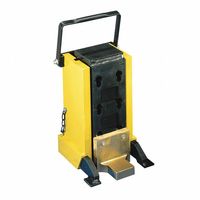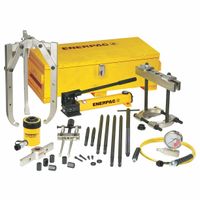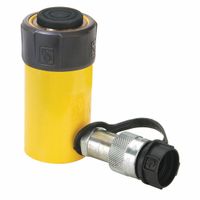Call +(254) 703 030 000 / 751 483 999 / 721 704 777
- Home
- Hydraulics
- Hydraulic Rams Tools
.....Read More
Frequently Asked Questions
What is a hydraulic ram and how does it work?
A hydraulic ram, also known as a hydram, is a self-powered pump that uses the kinetic energy of flowing water to pump a portion of that water to a higher elevation. It operates without any external power source, relying solely on the principles of hydrodynamics.
The basic mechanism involves two main valves: a waste valve (also called a "farting valve" or "impulse valve") and a delivery valve. When water flows down a drive pipe into the ram, it builds up pressure. Once the velocity of the water reaches a certain point, the waste valve is forced shut by the water's momentum. This sudden closure creates a pressure surge (water hammer effect) within the ram.
This pressure surge is then used to open the delivery valve, forcing a small amount of water into an air vessel. The air in the air vessel is compressed, acting as a cushion and smoothing the flow of water out of the delivery pipe. After the pressure surge subsides, the waste valve reopens, allowing water to flow freely again, and the cycle repeats.
Hydraulic rams are typically used in rural areas or remote locations where electricity is unavailable, making them a sustainable and cost-effective solution for water supply, particularly for irrigation or small-scale domestic use. Their efficiency depends on the height difference between the water source and the ram (the "fall") and the desired delivery height.
How do you choose the right hydraulic tool for a specific application?
Choosing the right hydraulic tool involves considering several factors to ensure efficiency, safety, and optimal performance for a specific application.
First, identify the application's requirements. This includes the type of work (lifting, pressing, cutting, bending), the force or pressure needed, the material being worked on, and the environment (e.g., confined spaces, outdoor conditions, hazardous areas).
Next, evaluate the hydraulic tool's specifications. Consider its maximum operating pressure, flow rate, reservoir capacity, and any specialized features. Ensure these specifications align with the application's demands. For instance, a high-force application will require a tool capable of higher pressure output.
Portability and power source are also crucial. Determine if a hand-operated, air-powered, or electric-powered hydraulic pump is most suitable. Hand pumps offer portability but are slower, while electric pumps provide continuous power for heavier tasks.
Safety features are paramount. Look for tools with pressure relief valves, load-holding capabilities, and robust construction to prevent accidents. Ergonomics and ease of use also contribute to safer operation.
Finally, consider the tool's durability and maintenance requirements. A well-built tool from a reputable manufacturer will offer longer service life and better reliability, reducing downtime and replacement costs. It's also important to factor in the availability of spare parts and service support.
What are the safety precautions when using hydraulic rams and tools?
Always wear appropriate personal protective equipment (PPE), including safety glasses, gloves, and steel-toed boots. Ensure the hydraulic ram and tools are in good working condition before use, checking for leaks, damaged hoses, or faulty connections. Never exceed the rated capacity of the ram or tool. Use the correct fluid for the hydraulic system and ensure the fluid level is adequate. Secure the load properly to prevent shifting or falling during operation. Always maintain a stable base for the ram and avoid placing any body parts between the ram and the load. Release pressure slowly and carefully after completing the task. Store hydraulic equipment in a clean, dry place to prevent corrosion and damage.
How do you maintain and troubleshoot hydraulic tools?
Maintaining and troubleshooting hydraulic tools is essential for ensuring their longevity, efficiency, and safe operation. Regular maintenance involves several key steps.
First, always keep the tools clean. Dirt and contaminants are major causes of hydraulic system failures. Wipe down tools after each use, paying attention to hoses, fittings, and moving parts.
Second, regularly inspect hydraulic fluid levels and quality. Low fluid levels can lead to cavitation and overheating, while contaminated or degraded fluid can cause pump and valve damage. Follow manufacturer recommendations for fluid type and replacement intervals.
Third, check hoses and fittings for leaks, cracks, or wear. Leaks can cause pressure loss and safety hazards. Replace damaged components immediately. Ensure all connections are secure to prevent air ingress, which can also lead to system inefficiencies.
Fourth, lubricate moving parts as recommended by the manufacturer. This reduces friction and wear, extending the life of the tool.
When troubleshooting, start with the basics. If a tool isn't performing as expected, first check for proper fluid levels, clean filters, and secure connections. Listen for unusual noises, which can indicate issues like cavitation or worn bearings. Check for overheating in the fluid or components, as this often points to internal leaks or system overload. If a tool loses power, inspect for external leaks or a malfunctioning pressure relief valve. For more complex issues, consult the tool's manual or a qualified hydraulic technician. Never attempt repairs beyond your expertise, as hydraulic systems operate under high pressure and can be dangerous.
What are the common applications of hydraulic rams in industry?
Hydraulic rams are widely used in various industrial applications due to their ability to generate immense linear force. In manufacturing, they power presses for stamping, forming, and molding materials like metal, plastic, and rubber. They are crucial in construction for heavy lifting, demolition, and operating machinery like excavators and bulldozers. The automotive industry utilizes hydraulic rams in vehicle lifts, assembly lines, and in manufacturing processes for components like brakes and steering systems. In the energy sector, they are found in drilling rigs and power generation equipment. Furthermore, hydraulic rams are essential in material handling systems, operating conveyor belts, forklifts, and lifting platforms, facilitating the movement of heavy goods in warehouses and logistics. Their reliability, precision, and power make them indispensable components across diverse industrial sectors.
How do you calculate the force output of a hydraulic ram?
To calculate the force output of a hydraulic ram, you need two key pieces of information: the hydraulic pressure (in pounds per square inch, PSI, or Pascals, Pa) and the effective area of the piston (in square inches, in², or square meters, m²). The fundamental formula is:
Force (F) = Pressure (P) × Area (A)
Here's a breakdown: * **Pressure (P):** This is the fluid pressure supplied to the ram, typically from a hydraulic pump. It's often measured in PSI in the imperial system or Pascals (Pa) or Bar in the metric system.
* **Area (A):** This refers to the effective area of the piston face that the hydraulic fluid acts upon. For a simple cylinder, this is the area of a circle, calculated using the formula: Area = π × (radius)² or Area = (π/4) × (diameter)². Ensure the units for area are consistent with the pressure units (e.g., if pressure is in PSI, area should be in in²).**Example:**
If a hydraulic ram has a piston with a 4-inch diameter (radius = 2 inches) and the hydraulic system operates at 2000 PSI:1. Calculate the piston area: Area = π × (2 in)² = 3.14159 × 4 in² ≈ 12.57 in²
2. Calculate the force output: Force = 2000 PSI × 12.57 in² = 25,140 pounds.It's important to note that this calculation provides the theoretical force. In practice, factors like friction within the cylinder seals and rod bearings can slightly reduce the actual output force.
What are the differences between hydraulic rams and hydraulic cylinders?
Hydraulic rams and hydraulic cylinders are both devices that use hydraulic pressure to generate linear force, but they differ in their construction and operation.
A hydraulic cylinder, also known as a double-acting cylinder, has two ports, allowing hydraulic fluid to enter and exit on both sides of the piston. This design enables it to generate force in both extension and retraction directions, making it versatile for a wide range of applications requiring precise control over movement.
In contrast, a hydraulic ram, often called a single-acting cylinder, typically has only one port. Fluid enters one side of the piston, causing it to extend. Retraction usually occurs due to an external force, such as gravity, or a return spring. This simpler design makes hydraulic rams suitable for applications where force is primarily needed in one direction, like lifting mechanisms or simple pressing operations. The key distinction lies in the ability of hydraulic cylinders to actively push and pull, while hydraulic rams primarily push and rely on external means for their return stroke.
How do you properly install and set up a hydraulic ram system?
To properly install and set up a hydraulic ram system, careful planning and execution are essential. First, select a suitable site for the ram, ensuring a sufficient vertical drop (drive head) from your water source to the ram and a clear discharge path for the waste water. The ram should be placed on a level, stable foundation, ideally concrete, to prevent movement during operation.
Next, install the drive pipe, which connects the water source to the ram. This pipe should be straight, free of kinks, and of adequate diameter and length according to the ram manufacturer's specifications. Any bends should be sweeping and gradual to minimize friction loss. Securely connect the drive pipe to the ram's inlet, using appropriate fittings and thread sealant to prevent leaks.
On the outlet side, connect the delivery pipe that carries the pumped water to your desired location. This pipe's size will depend on the required flow rate and distance. Ensure all connections are watertight.
Before starting, check for leaks throughout the system. Then, prime the ram by manually opening and closing the waste valve a few times to allow water to fill the drive pipe and the ram's body. Once the ram is primed, the waste valve should begin to cycle automatically, indicating the system is working. Fine-tune the waste valve's adjustment screw to optimize the ram's efficiency, balancing water output with waste water discharge. Regularly monitor the system for smooth operation and perform routine maintenance, such as cleaning the intake screen and checking for debris in the ram's components.
What are the benefits of using hydraulic tools over manual tools?
Hydraulic tools offer numerous advantages over their manual counterparts, primarily due to their ability to generate and apply significantly greater force with less effort. This increased power translates to higher efficiency and productivity in various applications, from construction and automotive repair to manufacturing and heavy lifting.
One key benefit is enhanced power and force. Hydraulic systems leverage the incompressibility of liquids to multiply force, allowing users to achieve tasks that would be impossible or extremely difficult with manual tools. For instance, a hydraulic jack can lift vehicles weighing tons, while a manual jack would struggle with a fraction of that load. This power also reduces the physical strain on the operator, minimizing fatigue and the risk of injury.
Precision and control are another significant advantage. Despite their immense power, hydraulic tools can offer fine-tuned control over the applied force and movement. This is crucial for delicate tasks where accuracy is paramount, such as in precision manufacturing or intricate assembly. Many hydraulic systems allow for variable speed and force adjustments, providing versatility for different job requirements.
Furthermore, hydraulic tools often boast greater durability and a longer lifespan. Their robust construction and enclosed systems protect internal components from dirt, moisture, and other environmental contaminants, leading to less wear and tear compared to exposed mechanical parts in manual tools. While they may require periodic maintenance, their overall longevity and reliability often outweigh the initial investment.
In summary, the benefits of hydraulic tools over manual tools encompass superior power, improved efficiency, reduced physical strain, enhanced precision, and greater durability, making them a preferred choice for demanding and precision-oriented applications.
How do you identify and fix leaks in hydraulic systems?
Identifying and fixing leaks in hydraulic systems is crucial for maintaining efficiency and preventing damage. The process typically involves several steps:1. Visual Inspection: Start by visually inspecting all components of the hydraulic system, including hoses, fittings, cylinders, pumps, and valves, for any signs of fluid leakage. Look for drips, wet spots, or residue around connections and seals.
2. Pressure Testing: If a visual inspection doesn't reveal the leak, pressure testing can help. Isolate sections of the system and apply pressure. A leak will cause a drop in pressure, indicating the faulty section.
3. Dye Testing: For elusive leaks, a fluorescent dye can be added to the hydraulic fluid. Operate the system for a while, and then use a UV light to scan for glowing areas, which pinpoint the leak source.
4. Sound and Temperature Checks: Listen for unusual hissing sounds, which might indicate a high-pressure leak. Also, check for localized hot spots on components, as these can be a symptom of internal leaks or blockages.Once a leak is identified, fixing it usually involves: * Tightening Connections: Often, leaks are due to loose fittings. Tightening them with the correct torque can resolve the issue.
* Replacing Seals and O-rings: Worn, cracked, or damaged seals and O-rings are common culprits. Replace them with new ones of the correct size and material.
* Repairing or Replacing Hoses and Lines: Damaged hoses or rigid lines must be repaired or replaced entirely. Ensure that new hoses are properly rated for the system's pressure and fluid type.
* Servicing or Replacing Components: If the leak is originating from a pump, cylinder, or valve, it may require internal seal replacement, repair, or a complete unit replacement by a qualified technician.Regular maintenance and timely leak detection are key to the longevity and optimal performance of hydraulic systems.






